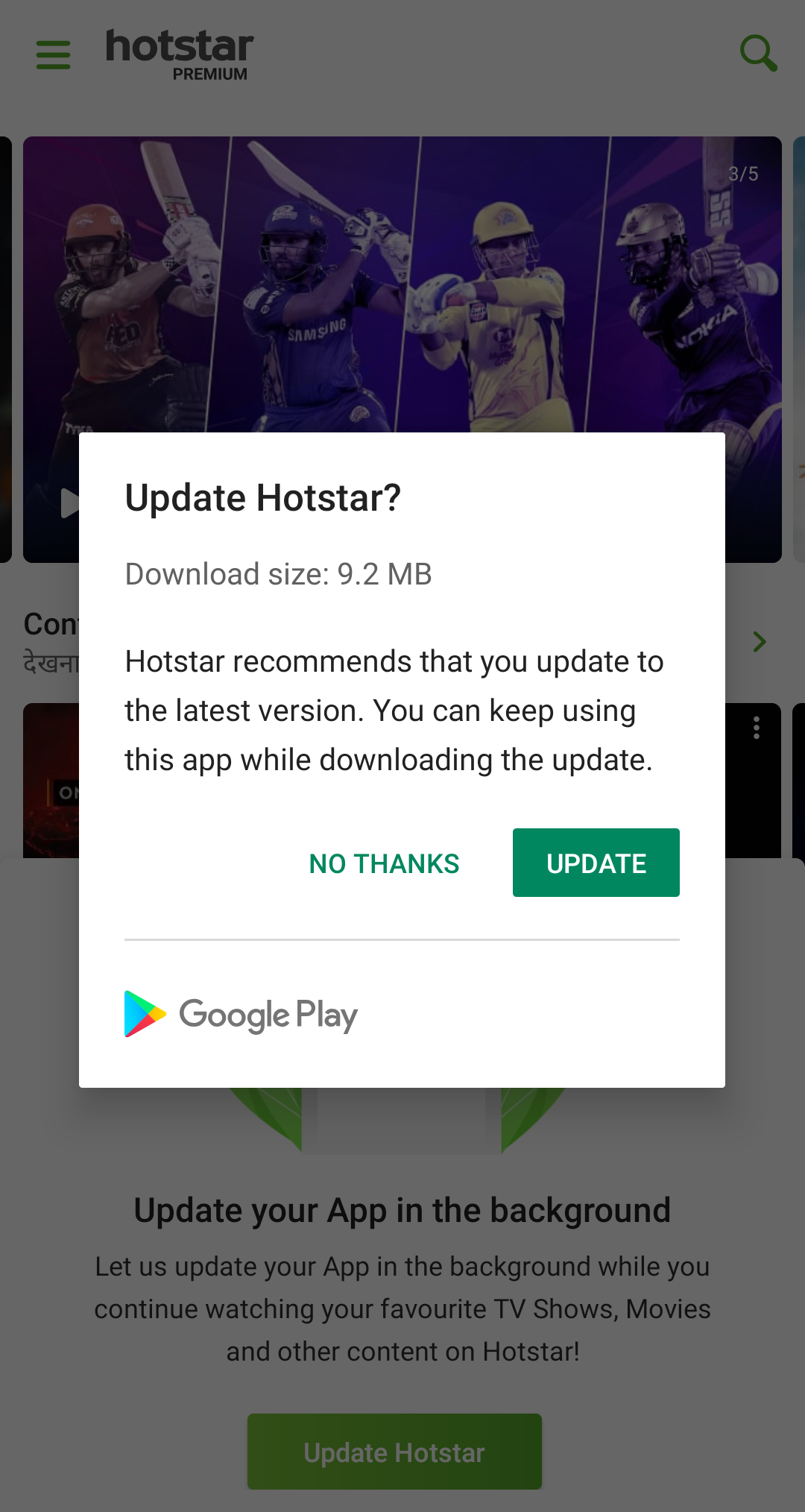Please try this once. Official Document for reference
Step 1: In the build.gradle file add the below library (please check and update latest play code plugin version)
implementation 'com.google.android.play:core:1.6.4'
Step 2: Declare the following variables in class (Ex MainActivity.java)
private AppUpdateManager mAppUpdateManager;
private int RC_APP_UPDATE = 999;
private int inAppUpdateType;
private com.google.android.play.core.tasks.Task<AppUpdateInfo> appUpdateInfoTask;
private InstallStateUpdatedListener installStateUpdatedListener;
Step 3: In onCreate() method add the below code (initializing variables)
// Creates instance of the manager.
mAppUpdateManager = AppUpdateManagerFactory.create(this);
// Returns an intent object that you use to check for an update.
appUpdateInfoTask = mAppUpdateManager.getAppUpdateInfo();
//lambda operation used for below listener
//For flexible update
installStateUpdatedListener = installState -> {
if (installState.installStatus() == InstallStatus.DOWNLOADED) {
popupSnackbarForCompleteUpdate();
}
};
mAppUpdateManager.registerListener(installStateUpdatedListener);
Step 4: In onDestroy() method of activity just unregister the listener
@Override
protected void onDestroy() {
mAppUpdateManager.unregisterListener(installStateUpdatedListener);
super.onDestroy();
}
Step 5: In onResume() we need to listen to both Flexible and Immediate updates by the below code.
@Override
protected void onResume() {
try {
mAppUpdateManager.getAppUpdateInfo().addOnSuccessListener(appUpdateInfo -> {
if (appUpdateInfo.updateAvailability() ==
UpdateAvailability.DEVELOPER_TRIGGERED_UPDATE_IN_PROGRESS) {
// If an in-app update is already running, resume the update.
try {
mAppUpdateManager.startUpdateFlowForResult(
appUpdateInfo,
inAppUpdateType,
this,
RC_APP_UPDATE);
} catch (IntentSender.SendIntentException e) {
e.printStackTrace();
}
}
});
mAppUpdateManager.getAppUpdateInfo().addOnSuccessListener(appUpdateInfo -> {
//For flexible update
if (appUpdateInfo.installStatus() == InstallStatus.DOWNLOADED) {
popupSnackbarForCompleteUpdate();
}
});
} catch (Exception e) {
e.printStackTrace();
}
super.onResume();
}
Step 6: In onActivityResult() we need to handle user click actions(only for flexible update)
@Override
protected void onActivityResult(int requestCode, int resultCode, Intent data) {
super.onActivityResult(requestCode, resultCode, data);
if (requestCode == RC_APP_UPDATE) {
//when user clicks update button
if (resultCode == RESULT_OK) {
Toast.makeText(MainActivity.this, "App download starts...", Toast.LENGTH_LONG).show();
} else if (resultCode != RESULT_CANCELED) {
//if you want to request the update again just call checkUpdate()
Toast.makeText(MainActivity.this, "App download canceled.", Toast.LENGTH_LONG).show();
} else if (resultCode == RESULT_IN_APP_UPDATE_FAILED) {
Toast.makeText(MainActivity.this, "App download failed.", Toast.LENGTH_LONG).show();
}
}
}
Step 7: Create a method to check update available or not and start the update (Immediate update)
private void inAppUpdate() {
try {
// Checks that the platform will allow the specified type of update.
appUpdateInfoTask.addOnSuccessListener(new OnSuccessListener<AppUpdateInfo>() {
@Override
public void onSuccess(AppUpdateInfo appUpdateInfo) {
if (appUpdateInfo.updateAvailability() == UpdateAvailability.UPDATE_AVAILABLE
// For a flexible update, use AppUpdateType.FLEXIBLE
&& appUpdateInfo.isUpdateTypeAllowed(inAppUpdateType)) {
// Request the update.
try {
mAppUpdateManager.startUpdateFlowForResult(
// Pass the intent that is returned by 'getAppUpdateInfo()'.
appUpdateInfo,
// Or 'AppUpdateType.FLEXIBLE' for flexible updates.
inAppUpdateType,
// The current activity making the update request.
MainActivity.this,
// Include a request code to later monitor this update request.
RC_APP_UPDATE);
} catch (IntentSender.SendIntentException ignored) {
}
}
}
});
} catch (Exception e) {
e.printStackTrace();
}
}
Step 8: Finely create a snack dialog or any alert to show the user that flexible update is downloaded and ready to update(need used action to start update - only for flexible update)
private void popupSnackbarForCompleteUpdate() {
try {
Snackbar snackbar =
Snackbar.make(
findViewById(R.id.id_of_root_loyout),
"An update has just been downloaded.\nRestart to update",
Snackbar.LENGTH_INDEFINITE);
snackbar.setAction("INSTALL", view -> {
if (mAppUpdateManager != null){
mAppUpdateManager.completeUpdate();
}
});
snackbar.setActionTextColor(getResources().getColor(R.color.install_color));
snackbar.show();
} catch (Resources.NotFoundException e) {
e.printStackTrace();
}
}
Step 9: Now call the method with the in-app update type(Flexible or Immediate) wherever you want to start to check updates.
//For Immediate
inAppUpdateType = AppUpdateType.IMMEDIATE; //1
inAppUpdate();
//For Flexible
inAppUpdateType = AppUpdateType.FLEXIBLE; //0
inAppUpdate();
Points to Remember:
The flexible update will download first then it will notify the user that download completed then the user has to start the update(options given above step 8).
There is an option in google play console to test in-app sharing, just we can upload normal apk(no need signed apk)to test.
https://support.google.com/googleplay/android-developer/answer/9303479?hl=en
Need to enable in-app sharing option in your test device play store app.
How to Enable Internal App Sharing for Android?
Still, any issue in the play store, just clear cache and clear data then restart the device once and try.


